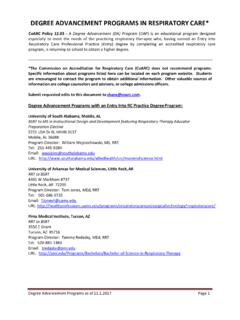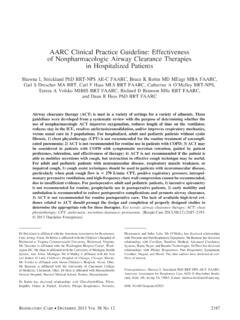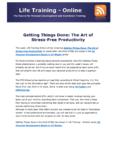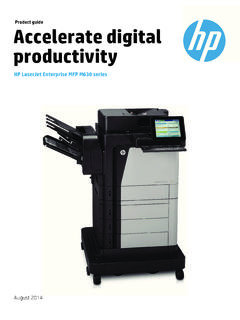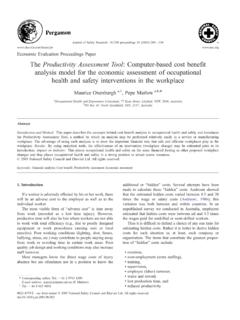Transcription of BEST PRACTICES IN RESPIRATORY CARE …
1 Issue PaperBEST PRACTICES IN RESPIRATORY care productivity AND STAFFINGN ovember 8, 2012 This paper provides guidance and considerations in the application of the AARC Position Statement: Best PRACTICES in RESPIRATORY care productivity and staffing adopted by the AARC Board of Directors in July and purposeThe provision of safe RESPIRATORY care is largely dependent on staffing adequate numbers of competent RESPIRATORY therapists (RTs). Understaffing puts at risk the welfare and safety of patients and may not allow care consistent with national guidelines and community practice. On the other hand, RESPIRATORY services represent a significant expense in the provision of health care and overstaffing RESPIRATORY therapists is neither productive nor 2012 AARC Position Paper regarding RESPIRATORY care productivity and staffing was approved and published to address growing concerns that inappropriate measures were being applied to determine the number of RT staff needed at a given institution.
2 This White Paper is intended to provide additional guidance to AARC members and to health care institutions and other providers to ensure that RESPIRATORY care productivity and staffing levels are provided within acceptable standards of practice recognized by the profession and that patient safety is for rendering RESPIRATORY careMedicare Hospital Conditions of Participation state that there must be adequate numbers of RESPIRATORY therapists2, and other personnel who meet the qualifications specified by the medical staff, consistent with state law. Medicare Hospital Conditions of Participation further require hospitals that provide RESPIRATORY care services to meet the needs of their patients in accordance with acceptable standards of practice. Acceptable standards of practice as noted in the Hospital Interpretive Guidelines for State Surveyors include compliance with applicable standards that are set forth in Federal or State laws, regulations or guidelines, as well as standards and recommendations promoted by nationally recognized professional organizations ( , American Association for RESPIRATORY care , American Medical Association, American Thoracic Society, etc.)
3 2 The documentation of competency in delivering RESPIRATORY care services may be assured by applicable state licensing boards and/or the attainment of RESPIRATORY therapy credentials awarded by the National Board for RESPIRATORY care (NBRC). All RESPIRATORY therapists employed by the hospital to deliver bedside RESPIRATORY care services must be legally recognized by state licensing laws, where applicable, as competent to provide RESPIRATORY care services. For states that do not require licensure, a CRT or an RRT credential from the NBRC should be required to assure documented competency and assure patient metrics described in this paper apply to the provision of care in which the RT provides direct oversight of care one patient at a time. Having therapists provide therapy to multiple patients simultaneously may be considered as a mechanism to reduce labor expenses.
4 This practice denies patients the direct supervision of a RESPIRATORY therapist for the duration of treatment, thus diminishing quality and potentially placing the patient at risk. Medications delivered by aerosol and other interventions provided by RESPIRATORY therapists are noted to have serious side effects that require rapid recognition and corrective action, which can only be achieved by direct observation of the patient. The practice of providing therapy to multiple patients simultaneously diminishes the RESPIRATORY therapist s time needed to observe the patient s tolerance and compliance with the medication and to provide patient education. More to the point of this paper, when multiple patients are treated simultaneously, the time standard for the treatment is no longer valid because it is based on the assumption that the therapist remains at the bedside of each patient throughout the patient s therapy.
5 9425 N. MacArthur Blvd., Ste 100, Irving TX 75063 T W 2012 AARC Position Paper regarding RESPIRATORY care productivity and staffing was approved and published to address growing concerns that inappropriate measures were being applied to determine the number of RT staff needed at a given , performing simultaneous treatments leads to reporting productivity values that are erroneously analysis and considerationsFrom a financial perspective, the over-estimation of staffing requirements leads to unnecessary and avoidable labor expenses. In contrast, understaffing may reduce salary cost in the short term, while producing more expense and lost revenue in the long run. Fiscally, there is much to be gained by staffing appropriately. Threats to revenue can result if prescribed treatments are not delivered and billed. Healthcare reforms associated with value-based purchasing will affect reimbursement payments from Medicare based on both clinical outcomes and patient satisfaction.
6 Thus, each institution should be financially motivated to assure adequate staffing for patients to receive appropriate care and avoid lengthy hospital stays or unnecessary readmissions. Further, missed and delayed treatments increase institutional negatively affects RESPIRATORY therapists morale because of inadequate time to provide needed assessments and Low morale may result in increased staff turnover. These are compelling reasons to ensure adequate staffing in the provision of RESPIRATORY metric, model, or system that is used to define RESPIRATORY staffing levels within institutions should recognize and account for all the activities required of a RESPIRATORY care Department in that institution. These activities vary greatly among institutions, and therefore must be determined on a case-by-case basis and approved by the medical staff and administration in individual to account for all medically necessary interventions, or use of inaccurate metrics of workload, may lead to underestimation of staffing requirements.
7 For instance: An exclusive focus on Current Procedural Terminology (CPT) codes (or other standards based only on billable activities) can lead to the omission of a large number of non-billed activities from the estimated RESPIRATORY care workload. Similarly, relying on internal measures, such as Total Patient Days, Average Daily Census, Adjusted Discharges per Patient Day, and Nursing hours per patient day (which do not accurately reflect RESPIRATORY therapist workload intensity), can lead to the omission of important and necessary tasks that contribute to workload and thus provide erroneous estimates of required majority of clinical procedures conducted by RESPIRATORY therapists have not been assigned a CPT code. CPT codes describe procedures and services provided by physicians and other health care professionals who bill for reimbursement. However, relatively few have been assigned to procedures and activities provided by RESPIRATORY therapists.
8 Examples of activities without CPT codes include but are not limited to: Airway Management Procedures Assessment/Screening Patients for Obstructive Sleep Apnea Assessment/Screening of Patients for Treatment Assessment/Screening of Patients for Invasive and Non-Invasive Ventilation Assessment/Screening of Patients for VAP Assessment/Screening of Patients for Weaning Cardio Version Monitoring of the Patient Continuous Oximeter Disease Management End Tidal CO2 Monitoring Endotracheal Tube Extubation Endotracheal Tube Repositioning and Securing Heliox Administration and Monitoring Incentive Spirometry Inpatient Sleep Apnea Monitoring Lung Recruitment Maneuvers Management of Patient Monitoring Devices Moderate Sedation Monitoring Nitric Oxide Administration Oxygen Administration and Monitoring Patient and Family Education, most instances Patient Transports Requiring Mechanical Ventilation or Airway Maintenance Rapid Response Calls RESPIRATORY care Consultations Spontaneous Breathing Trials Tracheotomy ManagementIn addition, there are additional activities required to support the safe and effective delivery of care that consume therapist time.
9 Many of these support activities are required by regulatory agencies. These activities must also be accounted for and include but not limited to: Calibration of Equipment Cleaning and Stocking of Equipment Clinical Instruction of Students Cylinder Inventory Management Department and Medical Center Meetings In-service Attendance Maintenance of Equipment Patient care Report/Handoff Patient care Rounds Performance Improvement Activities Quality Control of Devices and Procedures Staff Education and TrainingRecommendations for using metrics to determine staffing levels1. Workload metrics used to predict staffing levels must include all clinical and support activities that RESPIRATORY therapists perform, as stated in the AARC position statement. An organization must account for all activities that are driven by physician orders or medical staff approved protocols.
10 If there is an obligation to perform the procedure, it must be used in determining required staff, regardless of eligibility for CMS payment. Clinical support activities should be included, such as labor law mandated paid breaks, shift report, participation in required training, or the need to safety test Because of varying time requirements for different RESPIRATORY care procedures, systems to determine staffing should be based upon statistically valid activity time standards for all the services provided by a department. Because of the significant variability in the nature and types of care rendered in treating patients in need of RESPIRATORY services, unweighted metrics such as patient days, billable procedures with CPT codes, total procedures, etc., should not be used to determine RESPIRATORY therapist staffing Relative value units (RVUs) have been adopted by CMS for physician reimbursement, and provide another mechanism to weight specific An RVU-based staffing program must be used with a department staffing plan that provides the ability to flex direct patient care staff based upon service needs.





